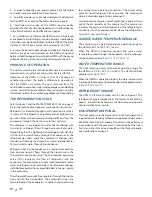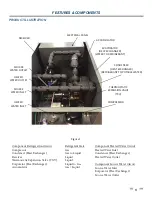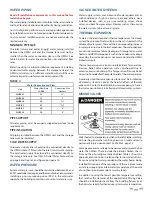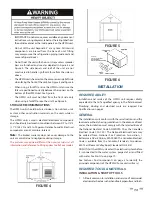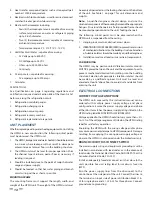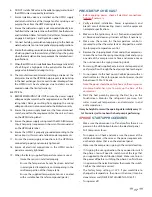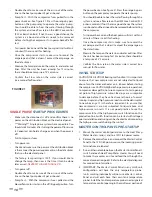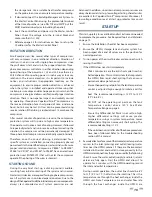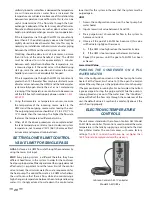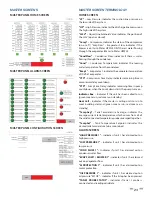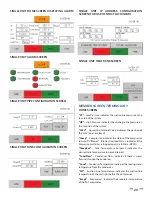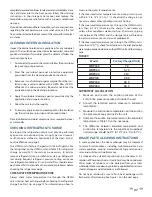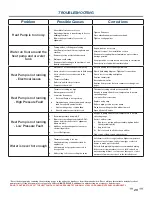
14
2. Heat transfer compound (paste) such as Honeywell part
number 107408 or equivalent.
3.
Electrical switch lock out device - used to secure disconnect
switches/breaker panels while servicing.
4. Electronic thermometer including:
•
Four (4) thermocouple sensors capable of measuring
surface temperatures on water or refrigerant piping
up to 2 inch diameter.
•
Two (2) thermocouple sensors capable of measuring
ambient air temperature.
•
Temperature range 32°F - 210°F (0°C - 100°C).
5. Volt-Ohm Multi Meter - capable of measuring:
•
AC Voltage up to 600 VAC.
•
DC Voltage up to 24 VDC.
•
Ohms up to 2,000,000 ohms.
• Continuity.
6. AC amp meter - capable of measuring:
•
AC amperage up to 200 amps.
7. Calculator.
SERVICE TOOLS
See Qualifications on page 3 regarding regulations and
certifi cations required under Section 608 of the Clean Air Act
before servicing the refrigeration circuit.
1. Refrigeration manifold gauges.
2. Refrigeration charging scale.
3. Refrigeration vacuum pump.
4. Refrigerant recovery machine.
5. Refrigerant reclamation storage tank.
UNIT PLACEMENT
Whether replacing existing water heating equipment or installing
the HPWH in new construction, the following critical points
must be observed: The HPWH unit:
1.
The HPWH, storage tank and water heater(s) should be located
in an area where leakage will not result in damage to
adjacent area or to lower fl oors in the building structure.
2. The HPWH unit must be level for proper operation. Shim
the channel type skid base, pad or fl oor as necessary if
leveling is required.
3. Should be installed close to the point of major hot water
usage and power supply.
4. Should be located so that hot water piping and branch
circuit wiring will be as short as possible.
MOUNTING FRAME
The mounting frame must support the length, width, and
weight of the HPWH unit. The weight of the HPWH unit must
be evenly dispersed across the footing channels on the bottom
of the unit. See Table 1 on page 7 for unit dimensions and
weights.
Note:
A qualified engineer should design and size the
structural components of the mounting frame and the appropriate
hangers. Structural channels in a fi eld-provided frame should
be mounted perpendicular to the unit’s footing channels
.
The following critical points must be observed when the
HPWH unit is suspended from the ceiling:
1. Hanging rods must not obstruct access doors.
2.
VIBRATION ISOLATORS ARE REQUIRED to prevent transmission
of mechanical vibration into the building structure. Selection
of suitable isolators should be made by a qualifi ed engineer.
3.
Installation must meet local seismic restraint requirements.
PAD MOUNTING
The HPWH may be pad mounted. Vibration isolator mounts
MUST BE placed between the unit and the equipment pad to
prevent mechanical vibration transmitting into the building
structure. Selection of appropriate vibration isolators should
be made by a qualified engineer. Unit must be level and
elevated at least 6” above fl oor to avoid dust and debris from
entering the unit.
ELECTRICAL CONNECTIONS
CORRECT VOLTAGE AND PHASE
The HPWH units covered by this instruction manual can be
ordered with multiple power supply voltage and phase
configurations. Ensure the power supply voltage and phase
at the job site matches the power supply ratings listed on the
HPWH rating label BEFORE INSTALLATION BEGINS.
Voltage applied to the HPWH should not vary more than +5%
to -10% of the voltage requirement listed on the HPWH rating
label for satisfactory operation.
Energizing the HPWH with the wrong voltage and/or phase
may cause permanent damage to HPWH components. Damage
resulting from applying the wrong power supply voltage or
phase to the HPWH is not covered under the limited warranty.
BRANCH CIRCUIT DISCONNECT SWITCH
The power supply wiring and equipment grounding must be
installed in accordance with local codes or, in the absence of
local codes, the National Electrical Code, ANSI/NFPA 70 or the
Canadian Electrical Code, CSA C22.1.
Install an adequately fused disconnect switch as close to the
units possible. See unit rating label for maximum fuse size
(MFS).
Run the power supply lines from the disconnect to the
control box at the side panel of the unit. Connect the lines to
the terminals on input side of power distribution block L1 &
L2 for single phase and L1, L2 & L3 for three phases. Connect
ground wire to ground lug.
Summary of Contents for HS 50 Series 100
Page 2: ......
Page 10: ...6 WATER TO WATER CYCLE ...
Page 32: ...28 TABLE 10 FIGURE 12 ...
Page 41: ...37 Technical Support 1 833 447 3201 ...
Page 42: ...38 Service Log Issue Description Date Servicer ...
Page 43: ...39 Service Log Issue Description Date Servicer ...
Page 44: ......





